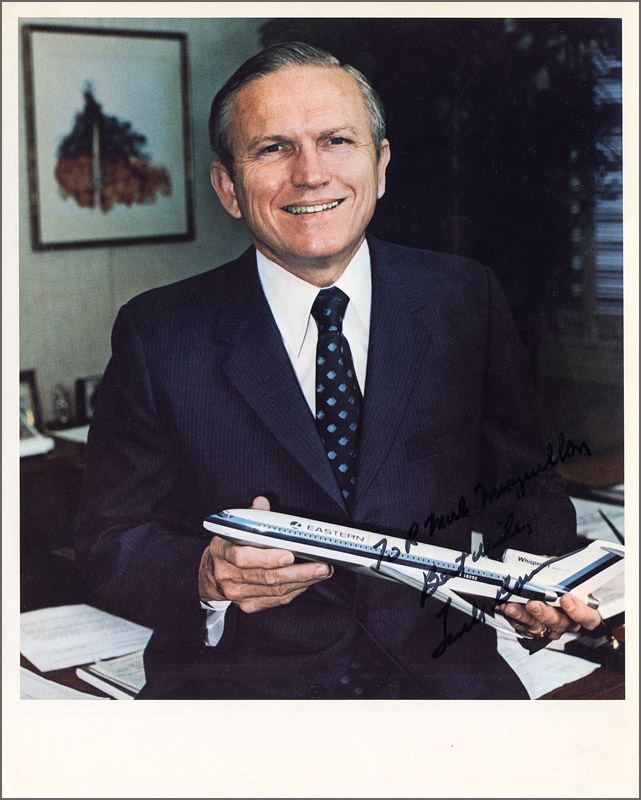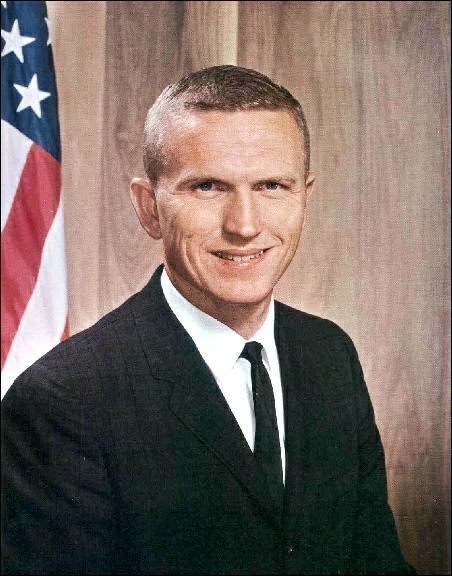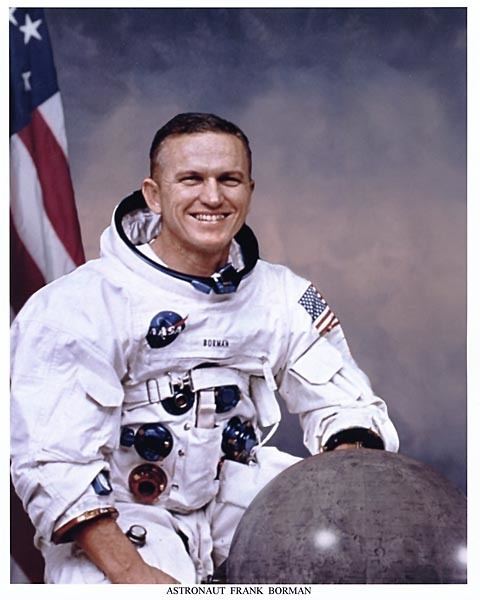Nationality American Name Frank Borman Time in space 19d 21h 35m Spouse Susan Borman (m. 1950) | Status Retired | |
 | ||
Children Edwin Borman, Frederick Borman Education California Institute of Technology (1957), United States Military Academy (1950), Tucson High Magnet School Similar People | ||
Apollo 8 astronaut colonel frank borman flies the p 63 kingcobra
Frank Frederick Borman II (born March 14, 1928), (Col, USAF, Ret.), is a retired United States Air Force pilot, aeronautical engineer, test pilot, and NASA astronaut, best remembered as the Commander of Apollo 8, the first mission to fly around the Moon, making him, along with crew mates Jim Lovell and Bill Anders, the first of only 24 humans to do so. Before flying on Apollo, he set a fourteen-day spaceflight endurance record on Gemini 7, and also served on the NASA review board which investigated the Apollo 1 fire. After leaving NASA, he was the Chief Executive Officer (CEO) of Eastern Air Lines from 1975 to 1986. Borman is a recipient of the Congressional Space Medal of Honor.
Contents
- Apollo 8 astronaut colonel frank borman flies the p 63 kingcobra
- Horizon 1965 1966 Man In SpaceFrank BormanWalt Cunningham
- Education and early career
- Flight experience
- Project Gemini
- Apollo program
- Eastern Air Lines
- Retirement
- In media
- Quotes
- Tributes
- References

Horizon 1965-1966 Man In Space/Frank Borman/Walt Cunningham
Education and early career

Borman was born on March 14, 1928, in Gary, Indiana, where the Frank Borman Expressway is named after him. He is of German descent, born as the only child to parents Edwin and Marjorie Borman. Because he suffered from numerous sinus problems in the cold and damp weather, his father packed up the family and moved to the better climate of Tucson, Arizona, which Borman considers his home town. He started to fly at the age of 15.

Borman graduated from Tucson High School in 1946. He received a Bachelor of Science degree from the United States Military Academy at West Point, in 1950, where he served as an Army football Manager, and along with part of his graduating class, he entered the United States Air Force (USAF) and became a fighter pilot. He received his Master of Science degree in Aeronautical Engineering from the California Institute of Technology in 1957. Later, Borman was selected for the Aerospace Research Pilot School (Class 60C, I) and became a test pilot. He completed the Harvard Business School's Advanced Management Program in 1970.

Borman married Susan Bugbee in 1950, and they have two sons: Frederick (born October 4, 1951) and Edwin (born July 20, 1953), and four grandchildren.
Flight experience

Following graduation, Borman was a career U.S. Air Force officer. Prior to joining the National Aeronautics and Space Administration's space program in 1962, he received his pilot wings in 1951 and served as a fighter pilot with the 44th Fighter Bomber Squadron in the Philippine Islands from 1951 to 1953, and as an operational pilot and flight instructor in various squadrons in the United States, from 1953 until 1956.
In 1957, he became an assistant professor of thermodynamics and fluid mechanics at West Point, where he served until 1960. In 1960, Borman began serving as an experimental test pilot engaged in organizing and administering special projects for the USAF Aerospace Research Pilot School, 1960–1962.
During his military service, he logged over 6,000 hours of flying Time.
In 1966 and 1968, Borman served as special presidential ambassador on trips throughout the Far East and Europe. In 1970, he undertook another special presidential mission, a worldwide tour to seek support for the release of American prisoners of war held by North Vietnam.
Project Gemini
Borman was selected by NASA for the second NASA astronaut group in 1962, and was chosen as the Command Pilot for Gemini 7. He was one of just four of this group chosen to command their first Gemini missions, the others being James McDivitt, Neil Armstrong, and Elliot See. (See was killed in a T-38 trainer jet crash three months before his mission. astronauts Gerald Carr and Joe Engle, selected later, also commanded their first space flights.)
Borman flew Gemini 7 in December 1965 with Pilot James A. Lovell, Jr. This was a long-endurance flight which set a fourteen-day record, and also acted as the target vehicle in the first space rendezvous performed by Gemini 6A. The two craft came within one foot (30 centimeters) of each other and they took turns flying around each other, taking both still and motion pictures.
Apollo program
Borman was selected in late 1966 to command the third manned Apollo mission, planned as an elliptical medium Earth orbit test of the second manned Lunar Module (LM) on the first manned launch of the Saturn V lunar rocket sometime in 1967 or early 1968. However, in January 1967, the crew of the first manned Apollo mission Apollo 1 (then designated "AS-204"), Virgil I. "Gus" Grissom, Ed White, and Roger B. Chaffee were killed in a fire aboard their Command Module, delaying the Apollo program. Following this deadly accident, the AS-204 Accident Review Board was charged with investigating the root causes of the fire and recommending corrective measures – Borman was chosen as the only astronaut to serve on the review board. In April 1967, while serving on the board, Borman was one of five astronauts who testified before a United States Senate committee investigating the Apollo 1 fire. His testimony helped convince U.S. Congress that Apollo would be safe to fly again.
Borman was then reassigned to his LM test mission, now planned to fly as "Apollo 9" in early 1969 after a first, low Earth orbit LM flight commanded by McDivitt in December 1968. But the LM was not ready for its first flight, leading NASA management to decide to replace Borman's mission with a lunar orbit flight using just the Command/Service Module as Apollo 8 in December, making McDivitt's flight Apollo 9 in March 1969. Borman's Lunar Module Pilot (and spacecraft systems engineer) was William Anders. The Command Module Pilot and navigator, Michael Collins, had to have back surgery and was replaced by his backup, James Lovell, reuniting Borman with his Gemini 7 crewmate. Apollo 8 went into lunar orbit on December 24 and made ten orbits of the Moon in 20 hours before returning to Earth.
And, from the crew of Apollo 8, we close with good night, good luck, a Merry Christmas, and God bless all of you—all of you on the good Earth.
The Apollo 8 mission is also notable for the Earthrise photograph taken by William Anders of the Earth rising above the Lunar horizon as the Command Module orbited the Moon, and for the reading from Genesis that was broadcast to Earth from Lunar orbit.
The success of Apollo 8 avoided jeopardizing the goal of making the first manned Moon landing by the end of 1969 by not waiting for the delayed LM, and also provided invaluable experience in navigation to the Moon.
Space journalist Andrew Chaikin claims that, following the death of Gus Grissom, Borman became astronaut chief Deke Slayton's choice to command the first Moon landing attempt. In the fall of 1968, Slayton offered command of the first landing to Borman, who turned it down, choosing to retire instead.
Eastern Air Lines
In early 1969, Borman became a special advisor to Eastern Air Lines and after retiring from NASA and the U.S. Air Force in 1970 as a colonel, he was made Senior Vice president-Operations Group at the company. In 1972, Borman received a phone call one evening informing him that Eastern Flight 401 had disappeared off the radarscope near Florida's Everglades. Soon, Borman himself was wading through the murky swamps, helping rescue crash victims and loading survivors into rescue helicopters.
He was later promoted to Executive Vice President-General Operations Manager and was elected to Eastern's Board of Directors in July 1974. In May 1975, Borman was elected President and Chief Operating Officer. He was named Chief Executive Officer of Eastern in December 1975 and became Chairman of the Board in December 1976.
After Borman became Eastern's CEO, the company went through the four most profitable years in the company's history. However, in 1983, contentious battles with labor unions, particularly the International Association of Machinists and Aerospace Workers (IAM) led the company to abandon several profitable programs and the resulting losses led to the sale of the airline to Texas Air Corporation, headed by Frank Lorenzo. Borman retired from Eastern in June 1986.
Retirement
Borman and his wife returned to reside in Tucson, Arizona, and then in 2006 they moved to Las Cruces, New Mexico, where he enjoyed rebuilding and flying vintage airplanes from the World War II and Korean War era. He was a member of the Society of Antique Modelers (SAM).
Borman gave the Commencement Address to the graduating class of 2008 at the University of Arizona.
He also delivered the Commencement Address to the graduating class of 2001 at Lynchburg College in Virginia.
For a time during his retirement, Borman was the majority owner of a Las Cruces Ford dealership founded by his son Fred Borman.
Borman has since appeared in the documentary When We Left Earth: The NASA Missions. On November 13, 2008, Borman and his fellow Apollo 8 crewmates, Jim Lovell and Bill Anders, appeared on the NASA TV channel to discuss the Apollo 8 mission.
Borman also appeared in the 2005 documentary "Race to the Moon", which was shown as part of the PBS American Experience series. The film, renamed in 2013 as "Earthrise: The First Lunar Voyage," centered on the events that led up to NASA's Apollo 8 mission.
Borman resides with his wife Susan Borman in Big Horn County, Montana. Following John Glenn's death in December 2016, Borman became the oldest living American astronaut.
In media
In the 1998 HBO miniseries From the Earth to the Moon, Borman was played by David Andrews.
Quotes
"There's no question that it was a coffin, and I'd have flown it gladly." — Public comment on the hazardous design and construction of the Apollo Command Module, during 1967 congressional testimony after serving on the AS-204 Accident Review Board. At the time, Borman was scheduled to command the third manned flight of the Apollo spacecraft. He coordinated the redesign effort to improve the safety of the spacecraft.
"Had that rocket not fired, I'd still be orbiting the Moon. Forever. And I really didn't want to do that." — Spoken of the Apollo 8 mission during the documentary When We Left Earth: The NASA Missions
"I've long said that capitalism without bankruptcy is like Christianity without Hell. But it's hard to see any good news in this." — as chairman of Eastern Air Lines
"A superior pilot uses his superior judgment to avoid situations which require the use of his superior skill." - Flying Lessons, Federal Aviation Administration (8 January 2008)
